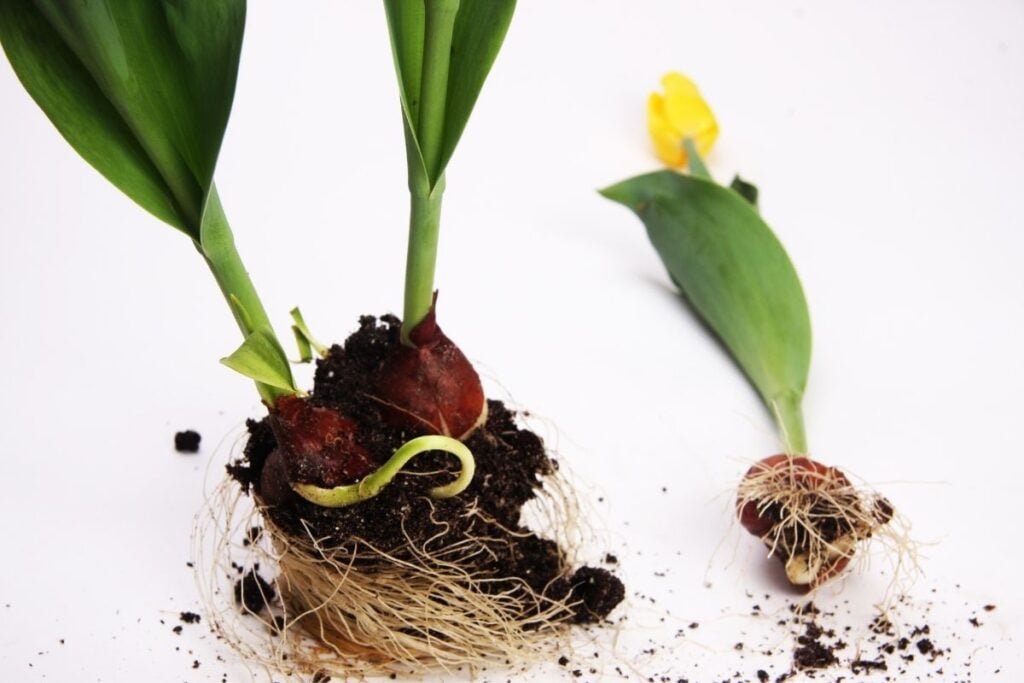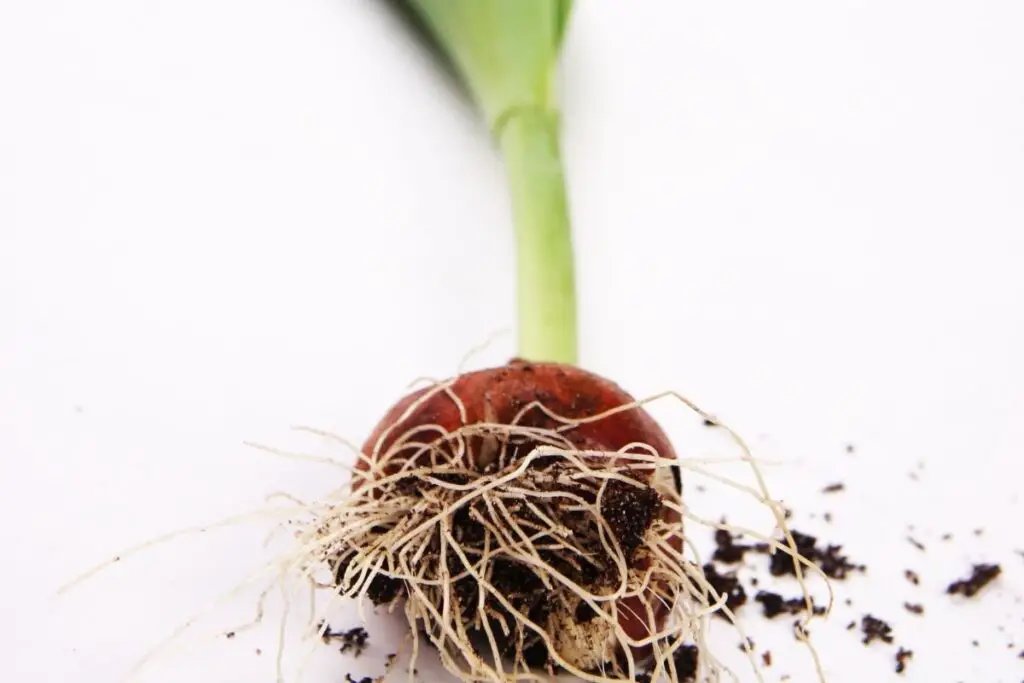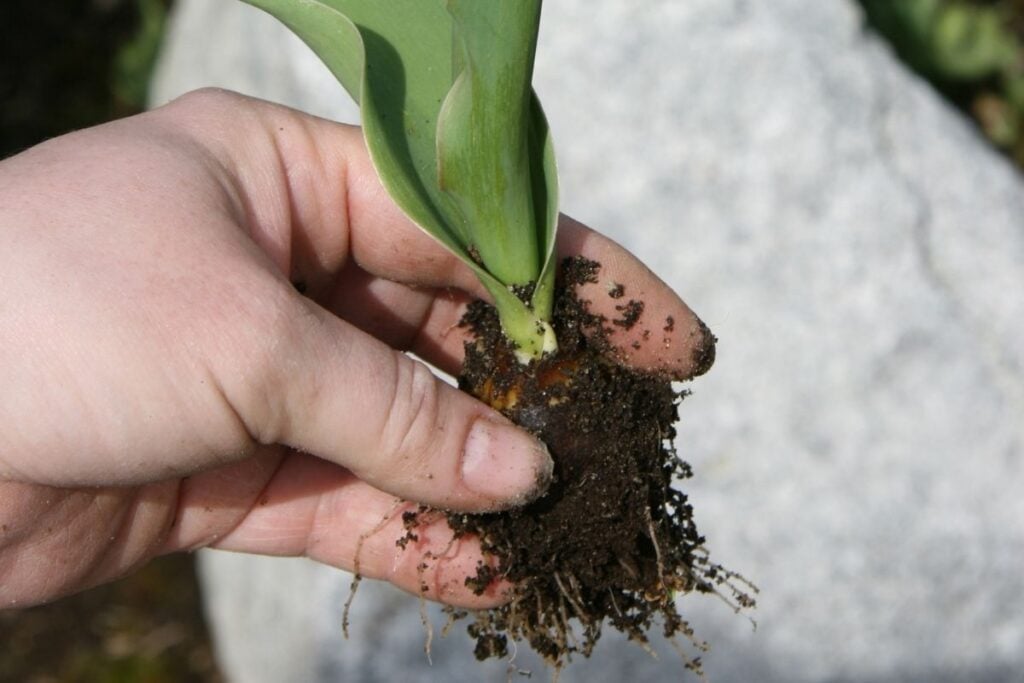Appreciated by all gardeners, tulips always bring an outburst of bright and vibrant colors to your garden during spring. But, sometimes despite all the care we give them, they start rotting from the bulbs.
There can be several causes of rotting bulbs in tulips and in this article we shall learn how to prevent tulip bulbs from rotting.
The tulip bulbs start rotting because of diseases caused by fungi and bacteria. So, by examining the bulbs before planting, stabilizing the soil condition, planting them in a proper site, avoiding weed growth, and keeping the garden clean, you can save the tulip bulbs from rotting.
If you are a fan of tulips but are worried about their rotting, this article will clarify every detail of how to take care of the tulips to keep them from rotting.

What are the reasons behind rotting Tulips?
The tulip bulbs rot because fungi and bacteria probably attack them. The bacterial and fungal diseases make the bulbs rot. Presumably, damp conditions attract more bacteria and fungi to the tulip bulbs.
Bulbs will be unable to handle extreme hot and humid conditions. If you live in a region where the USDA hardiness zones are 8 or above, the tulip bulbs won’t survive. The weather becomes too much warm for the bulbs to handle.
The tulip bulbs need the chilling weather of winter after being planted in the fall. This cold weather supports them in developing roots, flower profusely in the following spring, and complete their lifecycle.
So, if your region has such a hot climate, you have to stop growing tulips in such weather. If you are still determined to grow them, you need to maintain the temperature of their surroundings and the soil.
Generally, the tulip bulbs remain dormant in the summers. By this feature, you can estimate that they don’t grow during summers. So, the rule is to avoid watering during the summers. If they remain damp in summers, they will start rotting.
Not only in summers should you keep the soil dry. Usually, the soil bed for tulips must be kept evenly moist. They only require watering once a week with 1-inch water. Extreme damp conditions will make the tulips susceptible to basal rot.
Types and identification of the different rots in tulips
All the types of bulb rot have more or less the same treatment. But, knowing the kind of rot will help you understand the reason behind it.
Some bulb rots happen due to damp conditions, and some will occur during hot and humid conditions. Knowing the proper rot occurrence will assist you in controlling such conditions for the tulips.
Now let’s learn how the rotting can be identified:
Gray bulb rot in tulips
This disease occurs due to the fungus named Rhizoctonia Tuliparum. Along with tulips, many other bulb plants get affected, like, Daffodils, Crocus, Hyacinths, Lilies, and many narcissus plants.
The tulip undergoes many problems immediately after the bulbs are planted or at the beginning of spring.
In this disease, the bulb’s color turns gray, weakening. When the bulbs are already infected, the plant will not grow out of the ground.
Sometimes, the tulips might sprout out even being attacked by the disease. But still, it will take a long time to get matured. The plant will start shriveling and will soon die before flowering.
Gray bulb rot will even appear in between your healthy tulips.
When you suspect gray bulb rot in the tulips, dig them out and examine them. If it is a gray bulb rot, the bulbs will be coated with soil all over.
You will find dry decay signs from the neck portion of the bulbs. The bulbs will develop a felt-textured mass of fungi between their scales.
Sometimes the bulbs and soil planted will have a white substance, like molds.
Tulip fire (Botrytis Tulipae or Botrytis Cinera)
Tulip fire is caused because of the fungus Botrytis tulipae or cinera. When this disease occurs in your tulips, the suspected reason is either insect damage or reckless handling of bulbs.
The signs of this disease are brown patches of dead tissues on the leaves and flowers of tulips. When the disease advances, the brown marks will start increasing.
Gradually, the affected leaves and foliage will shrivel and become brown.
The flowers and foliage with brown discoloring will look as if they were burnt. The leaves will get disfigured. The stems will become weak and tumble. The affected bulbs will be covered with lesions.
The brown spots in the leaves will get covered with molds. They will later on form small black spots.
Looking for gardening supplies? We have tested 100's of products before recommending them to you guys. Check out our best pick below:
| Image | Gardening Supplies | Best Price? |
|---|---|---|
 Top
Top Top
Top | Raised Garden Bed Kit | Check On Amazon |
 | XLUX Soil Moisture Meter, Plant Water Monitor, Soil Hygrometer Sensor for Gardening, Farming, Indoor and Outdoor Plants, No Batteries Required | No Results |
 Top
Top Top
Top | 82 Pcs Garden Tools Set and Extra Succulent Tools Set | Check On Amazon |
 | Joeys Garden Expandable Garden Hose with 8 Function Hose Nozzle, Lightweight Anti-Kink Flexible Garden Hoses, Extra Strength Fabric with Double Latex Core, (50 FT, Black) | No Results |
 Top
Top Top
Top | Dual Chamber Compost Tumbler | Check On Amazon |
 Top
Top Top
Top | Sunnyglade Plant Stakes | Check On Amazon |
 Top
Top Top
Top | Organic Cold Pressed Neem Seed Oil | Check On Amazon |
 Top
Top Top
Top | Mighty Mint Gallon :-Insect and Pest Control Peppermint Oil | Check On Amazon |
 Top
Top Top
Top | Scotts DiseaseEx Lawn Fungicide | Check On Amazon |
 Top
Top Top
Top | Jacks Classic 20-20-20 All Purpose Fertilizer | Check On Amazon |
 Top
Top Top
Top | 30,000 Seeds Pollinator Attracting Wildflower Mixture | Check On Amazon |
 Top
Top Top
Top | Survival Vegetable Seeds Garden Kit-Over 16,000 Seeds | Check On Amazon |
Tulip-Fusarium Basal rots
The fungus Fusarium oxysporum f. sp causes it. The fungus stays inside the soil and over plant debris. However, the disease is extensive but is not as weighty as the Tulip fire. Fusarium basal rot is harsh for some tulips and mainly occurs while the bulbs are in storage.
The fungus enters through the plant’s roots, gets into the tissues of the bulbs, and inhabits the basal plate of the young bulbs. The disease spreads more on the outer scale of the bulb.
When the disease occurs, the tulip leaves become red, wilt, and the plant will die. The bulb and even the roots will rot and die.
When you put these diseased bulbs for storage, they look pale and white with a firm shrinking base overlaid with white or pink-colored fungal growth.
When the problem becomes severe, the bulbs become soft and mushy and release a foul smell.
The plant will have stunted growth when forced to grow, and leaves will be yellow prematurely. The plant dies before flowering. The stems will have dark smears all over.
Tulip crown rot
This disease is somewhat associated with Gray bulb rot. This disease happens due to the fungus Sclerotium delphinii.
When the bulbs get infected by the disease, you will notice a chalky-colored rot along with some white strands releasing the odor of mushrooms.
When contaminated, the stems will have white masses all over, which will turn into a red or tan color. The foliage, too, will turn red. Leaves will wilt and die before their natural death time.
The disease spreads intensely when sent for storage during hot and moist situations. Crown rot will spread more during hot and high humid circumstances.
Black rot
Caused by the fungus Sclerotinia sclerotiorum, Black rot is a soil-borne disease that will occur and even progress in cold temperatures.
When they infect the bulbs, they will have white substances, later becoming dark in color. This black color will develop into soft black spots all over the bulbs.
The rotten bulb and the stems growing out of it will start falling into pieces of black fungus masses. The leaves of the tulips will become red and start wilting.
Once reached, the spores will stay in the soil for at least 2 years. So when you again opt for planting, avoid the diseased soil area for at least 5 years.
How to keep the tulips from rotting?

With quick identification and treatment, you can bright back your plant if the disease is caught early by the initial symptoms.
But, the best to stop the diseases from killing your tulips is prevention. With suitable preventive measures, your tulips will keep flowering all spring.
Let’s see how you can keep the tulips from rotting:
Check the weather conditions.
If you live in a region where the temperatures are pretty warmer, like zones 8 or above, you need to avoid growing tulips.
The tulips will get more attractable to diseases if they grow in a warm and humid environment. The bulbs will need a cold period to develop roots and flower abundantly.
Some growers let the bulbs remain underground instead of digging and storing them. You can do this if you live in a cold region. But in tropical areas, leaving the bulbs in the ground will rot them.
But, you can fool the bulbs by giving them this cold condition while storing them in refrigerators.
When stored in the fridge for 12 to 15 weeks, the bulbs will get enough cold and survive when again planted in the fall. While keeping them in the fridge, make sure you keep them away from fruits. Else the ethylene gas released by fruits can damage the bulbs.
You can also add 2 to 3 inches of mulch after planting in the fall. This will keep the soil temperature cool and moist.
As the mulch will keep the soil moist, check the soil’s moisture before watering. Too much moisture will, again, rot the bulbs.
Also read: What Temperature Do Tulips Need? (+Growing Them At Different Temperature)
Clean the garden tools before and after use
While utilizing garden tools, like knives, pruners, spades, clippers, trowels, or scissors, you should clean and sanitize them before and after usage.
When you use them while digging up any diseased plant or bulb, the fungus or bacteria will stay on the tool too. So, you must clean them.
Before using them to dig up the bulbs or plant them, you must disinfect them to avoid spreading any virus or bacteria from the tools to the healthy plant or bulb.
After working any garden work, soak the tools in bleach water for a few hours. Rinse them very well with normal water after that.
Examine the bulbs closely

Before you opt for planting the bulbs, you must examine them very well. Whenever you find any signs of diseases, like black spots, molds, soft and mushy bulbs, pinkish or reddish color, discard them immediately.
Remember that a healthy bulb will always remain firm, dry, and free from all kinds of spots on its body.
Avoid using locations for planting where the rot already took place once
A lot of bulb rot diseases get spread through the soil.
If you have ever had any such disease, avoid planting the bulbs in the areas where rot already took place. At least for 5 years, avoid that area. After 5 to 6 years, the fungal spores might get away totally.
Even if you have sanitized the place well, you might not be sure that the spores have already disappeared or are still present. So be wise and make the right decisions.
Improve soil drainage
These diseases will happen and spread more in damp conditions. So, you must keep the soil from getting soggy. Tulips need their soil bed to be evenly moist. Water them once a week with 1-inch water.
But before the next watering, check the moisture level. If the top 1-inch feels dry, you can water them again. Avoid watering for some days when it rains vigorously. The heavy rain will do the watering job.
Add mulch to the soil bed. This will improve drainage by absorbing excess water from the soil. Mulch will also improve soil fertility.
Also read: What Kind Of Soil Is Good For Tulips? (Best Soil Mix)
Avoid wet locations
You should avoid locations where the soil always remains wet. A spot under an overhanging roof from where rainwater runs and falls over the soil and spots near fountains are some all-time damp places.
These are the places you need to avoid planting tulips; else, the bulbs will die of rotting.
Always plant the tulips in a sunny spot where they will receive full sun and well-drained soil. You can plant them on raised beds. Raised beds will drain water satisfactorily than the ground.
However, they can warm up the soil too. But, don’t worry. Proper watering and adding mulch will stabilize the soil temperature. At least, the bed will be free from excess moisture.
Keep the garden clean
The fungus and bacteria stay in the plant debris for coming back in the next season to attack again. Thus, you must keep the garden clean and remove all the debris from the garden after digging, planting, or treating any problem.
When you need to discard anything, like infected leaves, stems, or bulbs, collect them together in a paper or bag and discard them altogether in the garbage.
To get rid of any other effects thoroughly, you can either bury them far away from your garden or just burn them.
Get rid of weeds
Every garden will have weeds. Weeds are the hosts for these fungal and bacterial pathogens, causing bulb rots.
As I said before, keep the garden clean. It also includes weeds. The fewer weeds in the garden, the more your tulips will be free of diseases.
Raised beds are again helpful here. Raised beds can stop the weeds from growing.
Fix the excess moisture problem
If your region bears humidity problems, you can increase air circulation.
Spread your garden rows far enough to the direction where they can get the prevailing winds. It will increase air circulation, decrease moisture levels and stop the fungus from spreading.
The winds will dry up the damp leaves and soil bed faster, thus reducing the risks of bulb rot.
Also read: How To Save Overwatered Tulips? (Possible Signs, Causes & How To Fix)
Final thoughts
The best method to keep your precious tulips from any rot is to keep them from getting rotted. For that, you need to follow some preventive measures, like avoiding prolonged saturated soil, hot and humid climate, and discarding bad bulbs.
Except for these three, you must also consider the other points I have explained. Though wet soil and humid climate are the statuses that can invite these fungi and bacteria to render disease and rot the tulips, you should always try to evade such conditions around your tulips.
Plant them in a sunny spot and well-drained soil, water them once a week, sanitize the garden tools, use good bulbs, keep the garden clean and try to understand the weather conditions.
With some of these preventive measures, tulips will be away from rots and will brighten up your garden every spring.
Source: Wikipedia, North Dakota Stae University, The Royal Horticultural Society.
